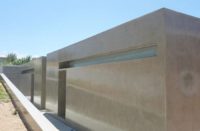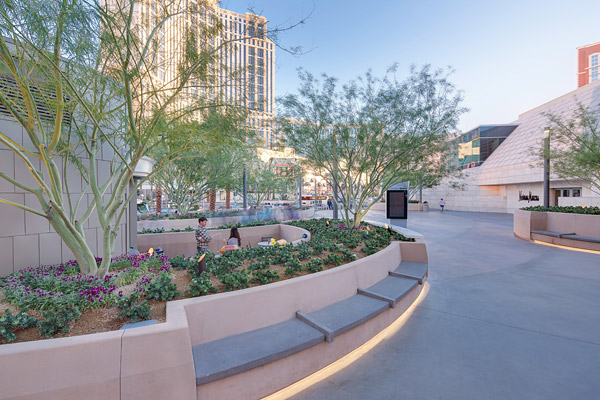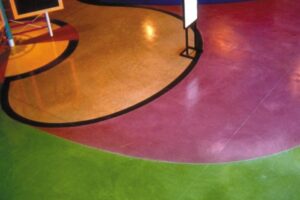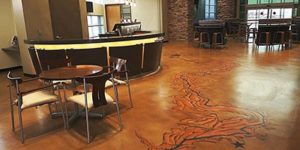In a city where each new project shines brighter than the last, an old favorite is taking on a new sparkle.
Fashion Show, a fixture on Las Vegas Boulevard (“the Strip”) since 1981, has just wrapped up a facelift that includes a 22,000-square-foot addition which provides space for five new restaurants on the mall’s front plaza, as well as upgrades to its landscaping and ingress-egress.
A large component of the new look: concrete provided by T.B. Penick & Sons Inc. of San Diego. With more than 1.9 million square feet of retail space devoted to more than 250 stores and no desire to close things down while the remodel was underway, the job was anything but easy.
Fortunately, Andrew C. Weber, Penick’s senior project manager for the project, says jobs such as this really play to the company’s strengths. Penick has three different divisions: a general contracts division, a structural concrete division and the architectural division, the latter recognized as one of the largest decorative concrete contractors in the country and the division responsible for this particular job.
“We get to do the fun stuff,” he says.
Setting the stage
In this case, Penick began by working with Callison, an international architecture firm based in Seattle, Washington, providing samples and different ideas for the project. Weber says they were then able to bid successfully with VCC LLC, the Dallas-based general contractor. “And they selected us to do the work,” he says.
VCC Senior Vice President Derek Alley says Penick was selected after a bid process, although price was not the only criteria for the choice. “We scour the marketplace for subcontractors and vendors who can understand the project scope, who show the right logistics plan and give us the confidence they can get it done,” says Alley. “We looked at multiple contractors, but they stood out.”
He admits that in a glamorous setting, concrete often isn’t the focal point, but it is critical to the project’s success. “A lot of patrons don’t necessarily look down, but the concrete is extremely important,” Alley notes. “This is the front door to the mall and the hardscape is a major part of the project’s scope. It really sets the stage.”
Work begins
Actual work on the project began early this year, and Weber says Penick’s part included several different components, such as about 18,000 contact square feet of walls and benches, and another 50,000 square feet of architectural concrete.
“The walls consist of a lot of radius work,” says Weber. “They meander through the property and have a battered edge, which is a tilted-back piece on the concrete. The very top is tilted. It’s very difficult to do this and required us to insert a foam piece under them to get the desired effect. It was very challenging.”
The benches, which also feature radius shapes with battered edges, were a mix of poured-in-place and precast concrete. “A lot of them have arm rests that weren’t precast,” he says. “However, the seats were poured in place. There were a lot of components on those, as well.”
Not even the flat concrete work on the job was easy. The existing concrete had been removed to the structural deck, causing varying elevations which required a lightweight cementitious infill to be installed first. “This system leveled the architectural concrete substrate and allowed the forms to be installed directly on the substrate,” says Weber.
The project also utilized four different colors of concrete, and Rigo Macias, Penick’s on-site superintendent, says that was further complicated by the site’s working conditions. Although foot traffic was curtailed during construction, it didn’t stop completely and vehicle traffic on the Strip went on as usual, so access to the site by heavy equipment was limited. Staging occurred in the mall’s underground parking structure.
“A lot of the work was arranging deliveries and moving everything from the street into the plaza,” says Macias. “Everything was poured through boom pumps, and on pour days we moved the pump one or two times a day. We would pour a strip on the north side and one in the center, then do another piece somewhere else. We hop-scotched the different colors so we could let one strip harden enough to pour the strip next to it.”
Weber says that presented a challenge in quality, as well. “We were also bouncing around in order to achieve VCC’s deadlines, and when you’re starting at one point and then jumping to another and then back to the place you were previously, we had to increase our manpower,” he says.
Until the final weeks of the job, Penick had an average of 25 workers onsite. While the hectic pace of the job drove some of that, the company also had to contend with abnormal working hours. “We’d start work around 2 a.m.,” Weber says. “One, there was far less traffic then. But, we did a lot of the work during the summertime and in Las Vegas it’s very hot. When you’re pouring concrete, 100-degree weather makes it very difficult.”
Macias says the last four or five months of the job consistently involved 10-hour shifts.
 On to Plan B
On to Plan B
Although the company had the work planned out, about three weeks into the project it had to rethink what it was doing due to several different challenges, from the elevations and radii involved to the finish. Part of the job involved applying about 21,000 contact square feet of a proprietary product called Penickrete, which is troweled on to create a quarried-stone finish.
“We had planned to pour the walls and benches and then strip the forms and finish them, but we weren’t able to because of all the components involved,” Weber says. “Eventually we ended up keeping the forms up and installing the Penickrete on the walls.”
Work — except for some punch list items — wrapped up in mid-November, and both Weber and Macias say they’re pleased with the job, as is VCC’s Alley, who praised Penick’s performance. “Their ability to coordinate, their ability to work under a fast-paced schedule and allocate the proper resources to get the job done the right way proved to be a great asset to this project,” he concludes.
Project at a Glance
Client: VCC LLC, Dallas, for General Growth Properties (GGP), Chicago. GGP owns the Fashion Show mall in Las Vegas.
Decorative concrete contractor: T.B. Penick & Sons Inc., San Diego
www.tbpenick.com
Crew: Andrew C. Weber, senior project manager; Rich Robertson, general superintendent; Rigo Macias, on-site superintendent. For most of the project, Penick employed a crew of 25.
Scope of project: Approximately 18,000 contact square feet of walls and benches; 50,000 square feet of architectural concrete; and application of 21,000 contact square feet of Penickrete.
Most challenging aspect: Completing a fast-paced job on a busy corner of the Las Vegas “Strip” while the mall remained open.
Products used: Penickrete at the walls, quarried stone finish on the flatwork

















